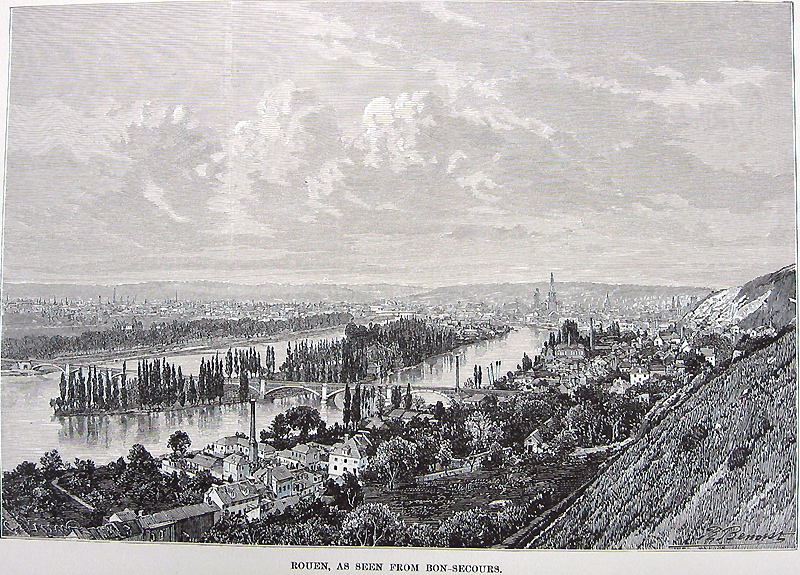|
|
ROUEN, AS SEEN FROM BON-SECOURS
Artist: unknown ____________ Engraver: unknown |

CLICK HERE TO SEE MORE 19th CENTURY EUROPE VIEWS LIKE THIS ONE!!
PRINT DATE: This engraving was printed in 1882; it is not a modern reproduction in any way.
PRINT SIZE: Overall print size is 6 1/2 x 10 inches, image size is 5 1/8 by 7 3/8 inches.
PRINT CONDITION: Condition is excellent. Bright and clean. Blank on reverse.
SHIPPING: Buyer to pay shipping, domestic orders receive priority mail, international orders receive regular air mail unless otherwise asked for. We take a variety of payment options. Full payment details will be in our email after auction close.
We pack properly to protect your item!
PRINT DESCRIPTION :
Rouen is the historical capital city of Normandy, in northern France on the River Seine, and currently the capital of the Haute-Normandie (Upper Normandy) region. Once one of the largest and most prosperous cities of medieval Europe, Rouen was the seat of the Exchequer of Normandy in the Middle Ages. It was one of the capitals of the Anglo-Norman dynasties, which ruled both England and large parts of modern France from the eleventh century to the 15th century. It was in Rouen where Joan of Arc was burnt in 1431. People from Rouen are called Rouennais. Rouen is known for its Notre Dame cathedral, with its Tour de Beurre (butter tower). The cathedral was the subject of a series of paintings by Claude Monet, some of which are exhibited in the Musée d'Orsay in Paris. The Gros Horloge is an astronomical clock (dating back to the16th century) though the movement is considerably older (1389). It is located in the Gros Horloge street. Other famous structures include the Gothic Church of Saint Maclou (15th century); the Tour Jeanne d'Arc, where Joan of Arc was brought in 1431 to be threatened with torture (contrary to popular belief, she was not imprisoned there); the Church of Saint Ouen (12th–15th century); the Palais de Justice, which was once the seat of the Parlement (French court of law) of Normandy and the Museum of Fine Arts and Ceramics which contains a splendid collection of faïence and porcelain for which Rouen was renowned during the 16th to 18th centuries. Rouen is noted for its surviving half-timbered buildings. There are many museums in Rouen: Musée des beaux-arts de Rouen, an art museum with pictures of well-known painters such as Monet and Géricault, Musée maritime fluvial et portuaire, a museum on the history of the port of Rouen and navigation, Musée des antiquités, an art and history museum with antic or gothic works, Musée de la céramique, Musée Le Secq des Tournelles... The Jardin des Plantes de Rouen is a notable botanical garden dating to 1840 in its present form; it was previously owned by Scottish banker John Law and the site of several historic balloon ascents. In the centre of the Place du Vieux Marché is the modern church of Saint Joan of Arc. This is a large, modern structure which dominates the square. The form of the building represents the pyre on which Joan of Arc was burnt. Rouen was also home to the French Grand Prix, hosting the race at the nearby Rouen-Les-Essarts track sporadically between 1952 and 1968. Much of the former circuit was extant into recent years, before a campaign in 1999 by Rouen authorities to obliterate remainders of Rouen's racing past. Today, little remains beyond the public roads that formed the circuit.
A RARE 19th CENTURY BIRD’S EYE VIEW OF EUROPE! |
|
|

